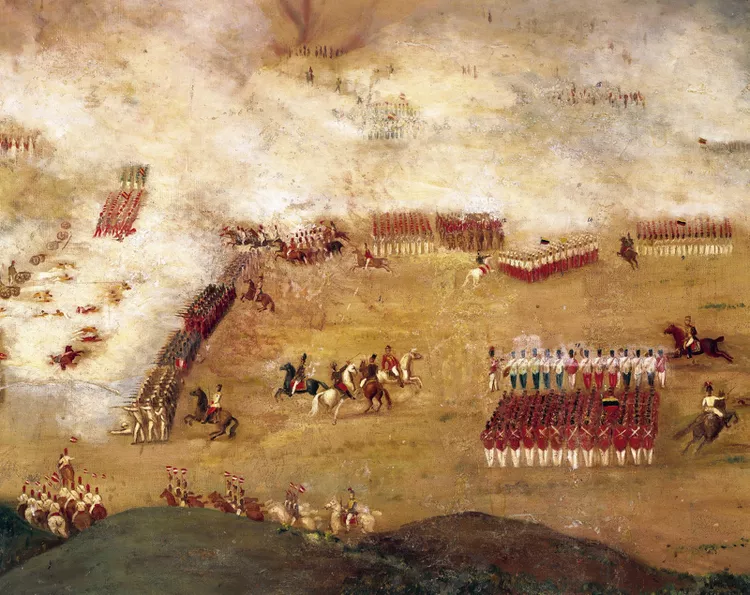Summary of December Festivities in Peru
If you’re heading to Peru in December, you’ll probably be thinking about Christmas. Christmas Eve and Christmas Day are certainly the focal points of the month, and Peru is a great place to celebrate the festive period, but they aren’t the only events in December.
You’ll also find festivities celebrating distinctly non-Christmassy events, including famous battles, pirate-defying religious statues, and spectacular Andean scissor dancing…
Homenaje a la Libertad Americana
December 2 to 9, Ayacucho, Huamanga Province
On December 9, 1824, a patriot victory over Spanish forces at the Battle of Ayacucho gained Peru its independence. This decisive victory also facilitated independence for much of South America, effectively liberating the continent.
Today, weeklong celebrations in Ayacucho, particularly within the district of Quinua, honor this significant occasion. The festivities, which include sporting events, cultural activities, and craft shows, attract participants from across South America.
Foundation of Chimbote
December 6, Chimbote
I’ve only ever met one foreign tourist who has visited Chimbote, a major fishing port on the north coast of Peru known for its strong fish odor. However, if you find yourself in Chimbote in December, you can expect plenty of parties celebrating its foundation on December 6.
Inmaculada Concepción
:max_bytes(150000):strip_icc():format(webp)/8558933792_c9e4099a47_o-5a198ff498020700362cfdff.jpg)
December 8, National Holiday
December 8 is a national holiday in Peru, celebrating the Immaculate Conception of the Virgin Mary (Inmaculada Concepción or Dia de la Purísima Concepción). Mary, daughter of Saint Joachim and Saint Anne, is believed to have been born free from original sin. This day commemorates her birth and is distinguished from the virgin birth of Christ. Celebrations vary by region, typically involving colorful street processions.
Foundation of Ferreñafe
:max_bytes(150000):strip_icc():format(webp)/Ferreafe_-_Iglesia_de_Santa_Lucia-2aea846e79f4413ea301fe8295aeb94b.jpg)
December 13, Ferreñafe, Lambayeque Region
Despite not being a major tourist draw, Ferreñafe, founded in 1550, is one of the most historic towns on the north coast of Peru. Anniversary celebrations on the north coast are typically vibrant, so consider visiting if you’re in the area. Additionally, you might explore one of the nearby museums during your stay.
Virgen de la Puerta
:max_bytes(150000):strip_icc():format(webp)/7328434366_fdf5319e7d_o-5a198eebeb4d52001a19311f.jpg)
December 12 to 15, Otuzco, La Libertad
The image of the Virgen de la Puerta (Virgin of the Gate) is highly revered in the city and province of Otuzco, located about two hours from Trujillo on the north coast of Peru. The statue of the virgin is associated with numerous miracles, the first of which involved pirates in 1674.
When the pirates threatened the town, the people of Otuzco turned to the image for protection. When the pirates ultimately did not attack, the townspeople expressed their gratitude to the virgin’s statue. The Virgen de la Puerta has since become an important religious symbol in Northern Peru, with its annual procession attracting a significant crowd of devotees.
Santuranticuy
:max_bytes(150000):strip_icc():format(webp)/peru--masked-dancers-on-christmas-day-in-cusco-s-square--plaza-de-armas--celebrating-the-andean-baby-jesus--nino-manuelito--125218738-597f30fe22fa3a0010f2c428.jpg)
December 24, Cusco
Santuranticuy, literally the “selling of saints,” is a traditional market held in Cusco’s Plaza de Armas on Christmas Eve. Artisans from across the region gather in the main square to sell handcrafted nativity scenes and other religious representations. You’ll also find plenty of traditional Peruvian snacks available for the bustling crowds of festive shoppers.
Christmas Eve and Christmas Day
:max_bytes(150000):strip_icc():format(webp)/peru--the-andean-version-of-baby-jesus--nino-manuelito--is-carried-in-cot-by-dancers-during-christmas-day-celebrations-529344168-5c1f7ac2c9e77c0001ec57c0.jpg)
December 24 and 25, National Holidays
Christmas Eve (Noche Buena) and Christmas Day (Navidad) both showcase some regional variations. A traditional coastal Christmas, for instance, might differ from a typical Andean celebration. Generally, Christmas Eve serves as the more vibrant day, filled with fireworks, lively festivities, and midnight gift-opening sessions.
Conversely, December 25 tends to present a more subdued atmosphere, with peaceful streets and a distinct recovery vibe (especially among the adults). Classic Christmas foods include panetón, hot chocolate, and for the main Christmas meal, roast turkey or lechón (roast suckling pig).
Danza de Tijeras
:max_bytes(150000):strip_icc():format(webp)/danzadelastijeras-5b3a298646e0fb00544bba8c.jpg)
December 24 to 27, Huancavelica
From December 24 to 27, the highland city of Huancavelica hosts a festival of the danza de tijeras (the scissor dance, also known as galas or laijas). This traditional Andean dance combines skill and athleticism with deeply rooted ritual significance. The Huancavelica festival attracts some of Peru’s most talented scissor dancers.
Anniversary of Madre de Dios
:max_bytes(150000):strip_icc():format(webp)/religion-in-peru-56a405875f9b58b7d0d4f7e7.jpg)
December 26, Department of Madre de Dios
The department of Madre de Dios was established on December 26, 1912. This region consists of both high and lowland jungle, bordered by the Peruvian departments of Puno, Cusco, and Ucayali, with Brazil and Bolivia to the east.
Anniversary celebrations feature singing, dancing, and street parades. The festivities occur throughout the region, with the largest events hosted in the departmental capital of Puerto Maldonado.




